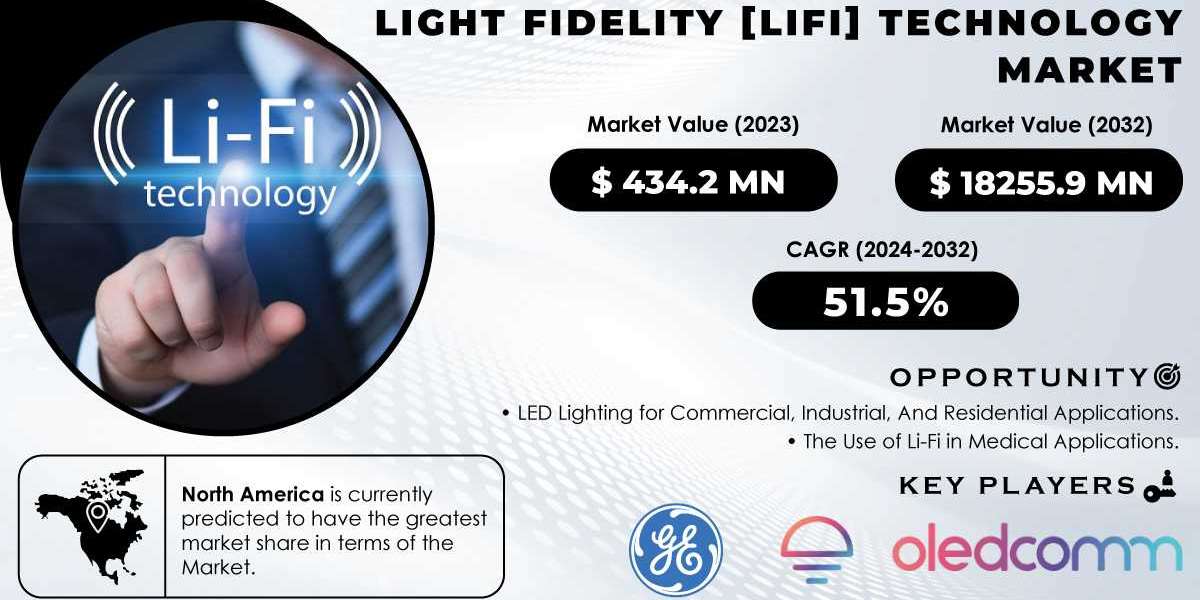Light Fidelity Technology 2024
In the ever-evolving landscape of wireless communication, innovative technologies continue to emerge, aiming to provide faster and more reliable data transmission. One such breakthrough is Light Fidelity (Li-Fi) technology, which utilizes visible light to transmit data, offering an alternative to traditional Wi-Fi. The Light Fidelity Technology Market Growth has gained significant traction, valued at USD 434.2 million in 2023 and projected to reach USD 18,255.9 million by 2032, growing at an impressive CAGR of 51.5% over the forecast period from 2024 to 2032.
Understanding Light Fidelity Technology
Light Fidelity, or Li-Fi, is a wireless communication technology that uses light waves from LED bulbs to transmit data. Unlike traditional wireless communication systems that rely on radio waves, Li-Fi utilizes the visible light spectrum, which is significantly larger than the radio spectrum. This characteristic allows for a higher bandwidth, enabling faster data transmission rates.
The concept of Li-Fi was first introduced by Professor Harald Haas from the University of Edinburgh in 2011. He demonstrated how LED lights could be modulated to send information, creating a new method of wireless communication. By turning LEDs on and off at incredibly high speeds—too fast for the human eye to perceive—Li-Fi can transmit data efficiently and securely.
Advantages of Light Fidelity Technology
One of the primary advantages of Li-Fi is its potential for extremely high-speed data transmission. Studies have shown that Li-Fi can achieve speeds up to 100 times faster than traditional Wi-Fi, making it an attractive option for applications requiring rapid data transfer. This capability is particularly beneficial in environments where large amounts of data need to be transmitted quickly, such as in hospitals, airports, and conference centers.
Moreover, Li-Fi operates in a frequency range that is unaffected by radio frequency interference. This feature makes it ideal for use in sensitive environments, such as aircraft and medical facilities, where radio signals may pose a risk. As a result, Li-Fi can provide a secure and reliable connection without the disruptions commonly associated with Wi-Fi.
Li-Fi also promotes energy efficiency. The technology leverages existing LED lighting infrastructure, which is widely used in various settings. By utilizing these lights for data transmission, organizations can reduce their energy consumption and operational costs, contributing to a more sustainable approach to wireless communication.
Applications of Light Fidelity Technology
The applications of Li-Fi are vast and varied, extending across multiple industries. In education, for instance, Li-Fi can facilitate faster internet access in classrooms, enhancing the learning experience. Students can connect to high-speed internet using Li-Fi-enabled devices, allowing for seamless access to online resources and interactive learning platforms.
In the retail sector, businesses can leverage Li-Fi to enhance customer experiences. By using Li-Fi technology in stores, retailers can offer personalized promotions and information to customers based on their location within the store, providing a more engaging shopping experience.
Moreover, in the healthcare industry, Li-Fi can improve communication and data sharing among medical staff. By utilizing Li-Fi for data transmission in hospitals, healthcare professionals can access patient records quickly and securely, leading to better patient outcomes.
Challenges and Limitations
Despite its numerous advantages, Li-Fi technology does face challenges. One of the primary limitations is its reliance on light; if there are obstacles or if the light source is turned off, the communication link can be interrupted. This characteristic restricts Li-Fi’s usability in certain environments where continuous light exposure is not feasible.
Additionally, the implementation of Li-Fi requires a significant investment in infrastructure, particularly in terms of upgrading existing lighting systems to LED technology. While many facilities are transitioning to energy-efficient lighting, the initial costs can be a barrier for some organizations.
The Future of Light Fidelity Technology
The future of Li-Fi looks promising, driven by advancements in technology and increasing demand for high-speed internet access. As smart cities and the Internet of Things (IoT) continue to develop, the need for efficient and reliable communication systems will only grow. Li-Fi can play a crucial role in this evolution, providing a complementary solution to existing wireless technologies.
Ongoing research and development efforts aim to address the current limitations of Li-Fi and expand its applications. Innovations such as integrating Li-Fi with other wireless technologies, like Wi-Fi and 5G, could enhance its capabilities and improve its practicality in various settings.
Conclusion
In conclusion, Light Fidelity technology represents a significant advancement in wireless communication, offering a fast, secure, and energy-efficient alternative to traditional Wi-Fi. As the Light Fidelity Technology Market continues to expand, driven by growing demand and innovative applications, it is poised to revolutionize how we connect and communicate in the digital age. By harnessing the power of light for data transmission, Li-Fi has the potential to enhance user experiences across various sectors, paving the way for a more connected future.
Contact Us:
Akash Anand – Head of Business Development Strategy
info@snsinsider.com
Phone: +1-415-230-0044 (US) | +91-7798602273 (IND)
About Us
SNS Insider is one of the leading market research and consulting agencies that dominates the market research industry globally. Our company's aim is to give clients the knowledge they require in order to function in changing circumstances. In order to give you current, accurate market data, consumer insights, and opinions so that you can make decisions with confidence, we employ a variety of techniques, including surveys, video talks, and focus groups around the world.
Read Our Other Reports:
Synthetic Data Generation Market Share














